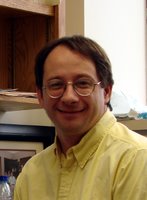Siegfried Musser, PhD

Professor
Contact
Cell Biology and Genetics
Room 449A Reynolds Medical Building
College Station,
TX
77843
smusser@tamu.edu
Phone: 979-436-0863
Fax: 979-847-9481
Musser Lab
Biography
Dr. Siegfried Musser earned an AB degree in biochemistry with High Distinction from the University of California, Berkeley in 1990.
He then obtained his PhD in chemistry from the California Institute of Technology in 1996, working in the laboratory of Sunney I. Chan.
After postdoctoral work at the University of California, Davis with Steven Theg from 1996-1999 and postdoctoral work at Brandeis University with Jeff Gelles from 1999-2001, he joined the faculty of Texas A&M University Naresh K. Vashisht College of Medicine in 2001.
Research Interests
- Protein Targeting and Translocation: The vast majority of proteins are synthesized in the cytoplasm, and yet proteins are found in every aqueous and membranous compartment within a given cell. Protein targeting and transport across lipid bilayers is therefore a fundamental process in all organisms. Up to approximately half of the proteins in an organism's proteome are inserted into or transported across membranes by protein translocation systems, or translocons. These translocons are typically elaborate molecular structures that facilitate the transport of desirable molecules while at the same time maintaining the membrane's function as a permeability barrier. While there are some similarities, protein translocation systems have surprisingly varied energetic and substrate requirements, recognition and gating mechanisms, and pore structure. Substantial biochemical work has provided a wealth of information about the signaling information, the protein substrates and transport cofactors, the energetic requirements and a general picture of the interplay amongst all these items for many protein transport systems. In many cases, structural studies are providing an emerging detailed picture of the molecular arrangement of protein components. However, there exists very little molecular detail of the specific interactions or the kinetic transitions between sub-states required for transport. We are currently working on two protein transport systems that translocate folded proteins: The Nuclear Pore Complex - The nuclear pore complex (NPC) spanning the double-membrane nuclear envelope fulfills the essential physiological role of facilitating and regulating the extensive trafficking between the cytoplasm and nucleoplasm in eukaryotic cells. It is unique among protein transporters because it regulates the trafficking of diverse substrates in both directions, and it can accommodate passage of molecules as large as ribosomal subunits. Ribosomal subunits, mRNAs, and tRNAs are exported to the cytoplasm. Proteins imported into the nucleus include histones, DNA and RNA polymerases, RNA processing proteins, ribosomal proteins, and numerous transcription factors. Current work is focused on using three-dimensional (3D) super-resolution single molecule fluorescence microscopy and single particle tracking techniques to explore different transport pathways and to determine the extent of their structural and functional intersections. The Tat Machinery - Many bacteria contain two very different general protein translocation machineries within the cytoplasmic membrane responsible for secretion from the cytoplasm to the periplasm. The Sec machinery (general secretory pathway) translocates polypeptides in an unfolded, linear configuration energetically driven by ATP hydrolysis and the proton motive force (pmf). In contrast, the Tat (twin-arginine translocation) machinery recognizes and translocates fully-assembled multi-subunit redox proteins in the presence of the pmf alone. The Tat system is responsible for the export of numerous proteins important for bacterial virulence in humans, and its absence often leads to growth defects. Since animals, including humans, do not contain homologues of Tat machinery proteins, inhibitors of Tat transport could potentially find use as novel antibiotics. Current work is focused on determining the oligomerization state of the active translocon and testing various predictions of our proposed Hairpin-Hinge translocation model.
- Biomolecular Coacervates (BMCs): BMCs [which includes membrane-less organelles (MLOs)] are liquid-like compartments within cells typically characterized by high concentrations of intrinsically disordered proteins (IDPs) and RNA molecules. Dozens of BMCs have been identified - examples include nucleoli, stress granules, and P bodies. These structures arise via liquid-liquid phase separation (LLPS), which is the spontaneous partitioning of macromolecules into dense and dilute phases due to favorable interactions between the separating molecules. We are currently using the FUS protein as a model for LLPS and phase maturation: FUS (fused in sarcoma) - FUS is a nuclear DNA/RNA binding protein that regulates transcription, splicing, and mRNA transport. It is a major aggregating protein in amyotrophic lateral sclerosis (ALS) and frontotemporal dementia (FTD). Arginine methylation defects and disease-causing mutations in FUS result in its accumulation in cytosolic membrane-less compartments called stress granules, and eventually, its aggregation in neuronal and glial cells, as seen in ALS and FTD patients. In vitro, FUS undergoes LLPS forming spherical droplets, which convert into solid, fibrous aggregates over time. Current work is focused on characterizing the physicochemical properties of FUS coacervates and their maturation to less mobiles phases.
Awards, Recognition and Service
- Junior Faculty Research Excellence Award conferred by Texas A&M Health Science Center - (College Station, Texas, United States)